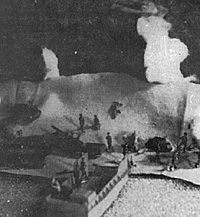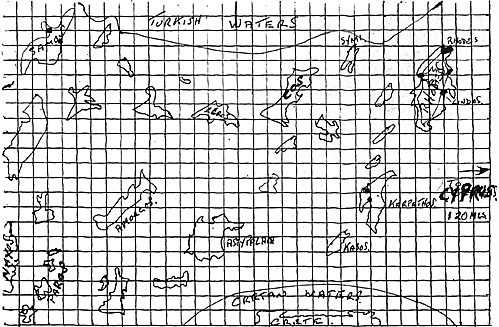 (The author is well-known as the genial Works
Manager of Miniature Figurines who also makes a
habit of either winning or being a finalist in the
World War II section at the National Wargames Convention.)
(The author is well-known as the genial Works
Manager of Miniature Figurines who also makes a
habit of either winning or being a finalist in the
World War II section at the National Wargames Convention.)
PART ONE
I am a confirmed modernist in spite of the virtual impossibility of representing even a World War II brigade action because movement and range scales are too formidable. But first-class wareames based on smaller organisations are possible, fought to rules that need be no more complicated than those of the Ancient period. After all, in trying to legislate for every conceivable action and situation modernists are only following the general trend which has been forced on rule writers, and Convention organisers, because the "barrack-room lawyers" twist rules to suit their own case. I would urge wargamers to get back to simple standards of scale, movement, time and basics backed by common-sense and the willingness to see the other fellows point of view. Arguments should be settled by an umpire, decided by the throw of a dice or better still by amicable negotiation.
I do not understand why wargamers should wish to fight only brigade or divisional battles - surely there can be first-class games based on much smaller organisations. In this series I am going to advocate small patrol actions involving 20-30 men or 2-3 tanks. Obviously a campaign cannot be run on this basis for to recreate one small patrol action two or three hundred times to represent an army, then move arrows across a map and call it a campaign is laughable. On the other hand, the blitzkrieg was based on lightning armoured strikes on narrow fronts, supported closely by aircraft, swinging round behind the enemy in pincer movements with men becoming secondary and virtually puppets of the machines. The performance of men supported by machines, as in Crete, was overshadowed by the spectacular movements of the blitzkrieg; the Western Desert campaign; and the gigantic clashes in Russia and Normandy. All hinged on the tank and its ancillary equipment.
Commando raids, such as St. Nazaire, make very good wargames; airborne raids are equally good fun and a fertile imagination can easily dream up variations such as operations in East Africa; Somaliland; Eritrea with an ultimate objective, such as the Germans wishing to establish a base for pocket battleships to go raiding in the Indian Ocean. Then there are the events in Syria, Iraq, Madagascar to give food for thought. Pacific Island 'hopping' makes first-class campaigning, although this could well be mainly naval and air with the land campaign becoming secondary.
I suggest a campaign in the Aegean which can accommodate all three services with none of them becoming so big as to be unmanageable.
I manage such a campaign by first drawing three identical gridded maps of the area with each square of the map representing 10 miles square. Two friends were pressed into becoming commanders and they wrote instructions to the organiser, who marked the master map and fought all the battles - sending results back to the commanders for their information.
LEGEND
August 1943
Both German and Allied armies are at full stretch, but the quiet Aegean area is being used as a rest and recuperation centre by the German army. British forces are to attack and island 'hop', keep the Germans at full stretch, clear the islands and establish a base for an invasion of Greece whilst threatening the Balkans. The British base will be Cyprus. The forces allocated may be used at commanders discretion. Material may only be replaced at organiser's discretion; extra material and forces over and above that originally allocated may be indented for and can be granted at the organiser's discretion.
CASUALTIES
One-third of the casualties will be counted as dead and not replaced; one-third will be out of action for one month campaign time: the other third will be ready for the next battle.
The German garrison of Crete is extra to their allocated forces and any British force moving into the sphere of Crete will be attacked by them. But they will not take part unless provoked by British forces crossing their boundary. It is not part of British commanders orders to violate the Cretan area or Turkish neutrality. Similarly any forces violating Turkish neutrality will be attacked by Turkish forces and the opposing side informed. All information of such operations will be given to Aegean Command.
ISLAND DESCRIPTIONS: All the islands are similar with very steep cliffs, they possess odd coves that could be used for small landings and their few beaches are only suitable for tank and vehicle disembarkation.
Supply over the beaches can only support small forces or a large force for a very short time (SEE SUPPLY). Small fishing villages may have little quays but only two towns have port facilities - the largest is Rhodes which has first-class harbour facilities but only limited repairs can be carried out there. The other is Samoa which is smaller but fairly well equipped.
Roads are not very good and are mainly tracks. It is not good tank country but armour may be used. The terrain is rather hilly; the hills are fairly high but also rolling; the countryside is (lusty with vineyards and olive groves. Some dry stone walls divide properties and there are many little stone houses and farms.

Back to Table of Contents -- Wargamer's Newsletter #146
To Wargamer's Newsletter List of Issues
To MagWeb Master Magazine List
© Copyright 1974 by Donald Featherstone.
This article appears in MagWeb (Magazine Web) on the Internet World Wide Web.
Other military history articles and gaming articles are available at http://www.magweb.com